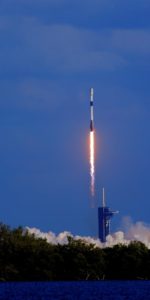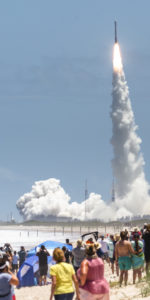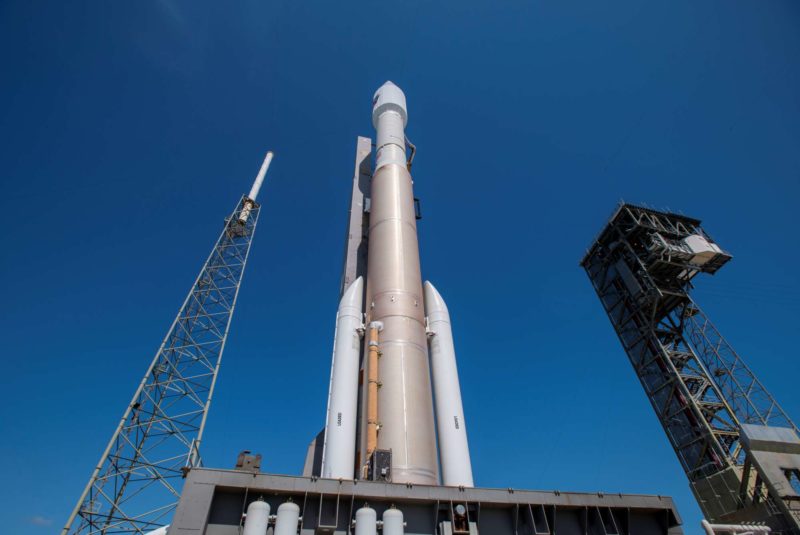
It has been a slow start this year for United Launch Alliance, but that’s about to change tomorrow, as they kick-off their first of 8 planned Atlas V launches this year with a mission to deliver the fifth geostationary-orbiting element of the Space-Based Infrared System (SBIRS GEO-5) into orbit for the U.S. Space Force.
Liftoff of the 194-foot tall rocket is targeted for 1:31 p.m. EDT on Tuesday, 18 May, and will mark the eighth flight of an Atlas V in a “421” configuration, equipped with a 13-foot-wide (4-meter) fairing, two strap-on solid-fueled boosters and a single-engine Centaur upper stage. The mission will also mark the 91st national security launch for ULA, and their 87th Atlas V flight. Launch was set for 17 May but was scrubbed during Centaur liquid oxygen (LOX) chilldown operations when the launch team identified an anomalous system response that could not be resolved in time.
“We take our role in national security very seriously and pride ourselves in being partners in space with the U.S. Space Force. We are launching critical capabilities for the warfighter and understand the need for reliability and consistency,” said Gary Wentz, ULA vice president of Government and Commercial Programs. “This mission marks our 91st launch in support of national security space. As we prepare to launch the fifth SBIRS mission, we thank our partners for their outstanding teamwork and collaboration.”
Uniquely, tomorrow’s launch will be the first time an Atlas V has flown in the 421 configuration to lift a SBIRS GEO satellite to orbit. The first three SBIRS GEO missions in May 2011, March 2013 and January 2017 rode “401” boosters, with no strap-on rockets, although January 2018’s launch occurred on a “411” with a single side booster. ULA’s CEO Tory Bruno noted at the time of the SBIRS GEO-4 launch that the additional impetus afforded by the single solid provided “enough energy to allow Centaur to be immediately deorbited” after its mission, rather than placing it into a designated disposal (or “junkyard”) orbit for slower decay and eventual re-entry. It is believed that the additional performance afforded by the 421 will permit a more optimized orbit for the payload.
SBIRS GEO-5 completed an ahead-of-schedule construction and testing campaign last October, with the elimination of unnecessary programmatic oversight and reporting, a restructured test program and a streamlined production schedule having enabled Lockheed Martin to finish SBIRS GEO-5 in only five years. Described as a “global guardian” for ballistic missile detection and defense, it is the fifth geostationary element of an upgraded set of space-based infrared “eyes” and follows four previous missions also launched atop Atlas Vs between May 2011 and January 2018.
SBIRS forms part of a multi-billion-dollar Pentagon effort to replace the earlier Defense Support Program (DSP) network of early-warning satellites, whose own ancestry extends back to the 1970s. It is expected to enable the United States’ space surveillance needs for the next two decades, with focuses including advanced early warning, missile defense and battlespace characterization. In its final form, it will comprise six GEO satellites at geostationary altitude, together with adjunct sensors aboard the HEO-1 and HEO-2 satellites, which were inserted into highly-elliptical orbits back in June 2006 and March 2008.
The successful launch of SBIRS GEO-1 in May 2011 marked the culmination of a long and tortured development process, which saw costs balloon by over 400 percent from an estimated $4 billion to over $17 billion. According to General Accounting Office (GAO) auditors, as reported by Defense Industry Daily in February 2013, the program suffered from “immature technologies, unclear requirements, unstable funding, underestimated software complexity [and] poor oversight”.
As circumstances transpired, the Air Force’s apparent lack of alternatives for an urgent national requirement to have an advanced infrared surveillance system in orbit to actively monitor ballistic missile launches and nuclear events seems to have prevented SBIRS’ cancelation. Its capabilities include highly sophisticated scanning/staring sensors, with improved infrared sensitivity and the scope to provide wide-area (“scanning”) surveillance and small-area (“staring”) observations. Three further SBIRS GEO satellites were launched in March 2013, January 2017 and January 2018.
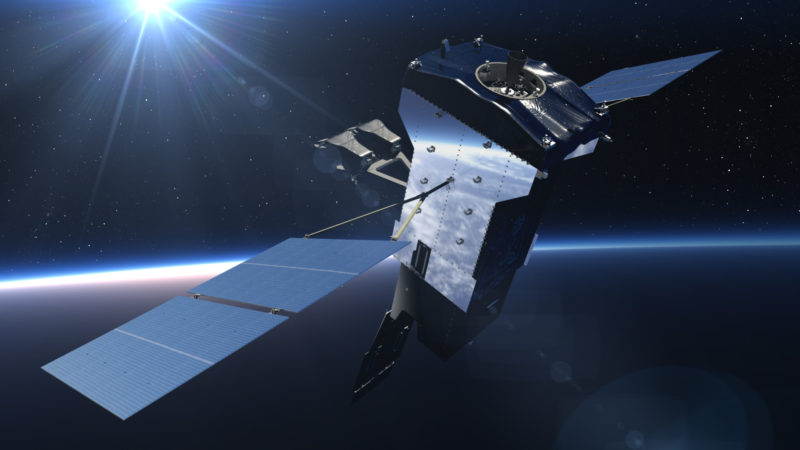
In the meantime, a $284.4 million contract for the purchase of long-lead items for GEO-5 and GEO-6 were awarded in March 2013, ahead of the definitive $1.86 billion deal between the Air Force and Lockheed Martin in June 2014 to fabricate both satellites. At the time of the award, it was noted that the contract formed part of “a thoughtful acquisition strategy aimed at further reducing cost and cycle time”. In particular, more than a billion dollars’ worth of saving were achieved through “block-buy” contracting practices and the elimination of unnecessary program oversight and reporting, a restructured test program and a streamlined production schedule.
In September 2017, both the GEO-5 and GEO-6 satellites wrapped up their Critical Design Review (CDR) at Lockheed Martin’s Sunnyvale, Calif., facility, with Col. Dennis Bythewood, director of SMC’s Remote Sensor Systems Directorate, praising the “resiliency” of the program. Upon the completion of the CDR, both satellites moved directly into manufacturing and integration. In February 2019, ULA was awarded a $441.6 million contract to launch three payloads—including SBIRS GEO-5 and GEO-6—with an expectation that the GEO-5 element would fly atop an Atlas V from Space Launch Complex (SLC)-41 at Cape Canaveral Air Force Station, Fla., as early as March 2021.
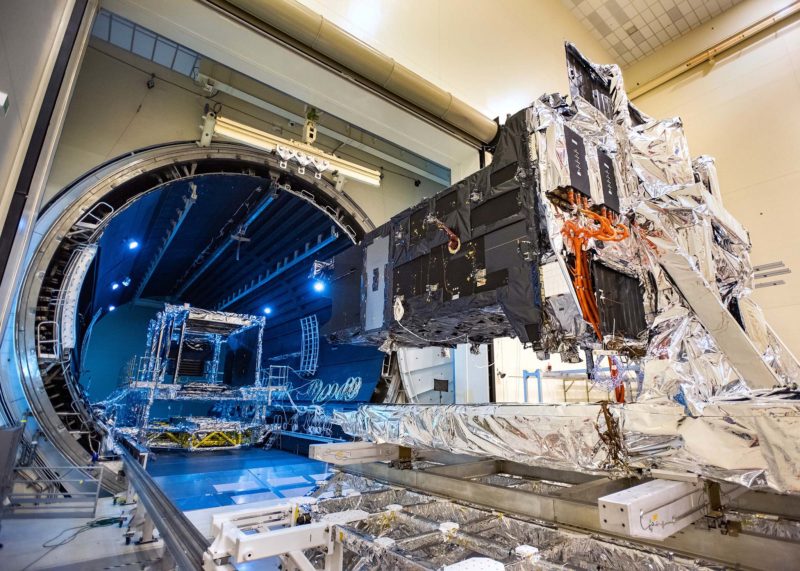
GEO-5 pressed smoothly through Thermal Vacuum (TVAC) testing last summer, which constituted a “major milestone” in readying the satellite for final assembly. “Lockheed Martin Space overcame COVID-19-related challenges,” noted the Air Force, “to maintain assembly and test operations with minimal impacts.” Following its completion last fall, SBIRS GEO-5 was delivered aboard a C-5M Super Galaxy transport aircraft from Moffett Airfield in California to the Space Coast in March.
The design of SBIRS GEO-5 marks the inaugural use of Lockheed Martin’s heavily modernized LM2100 “Combat Bus”, carrying twin solar arrays and a powerful communications and imaging payload. In what has been described as a “technical refresh update”, their newer components and more modern electronics are expected to achieve a boost in capability and reliability.
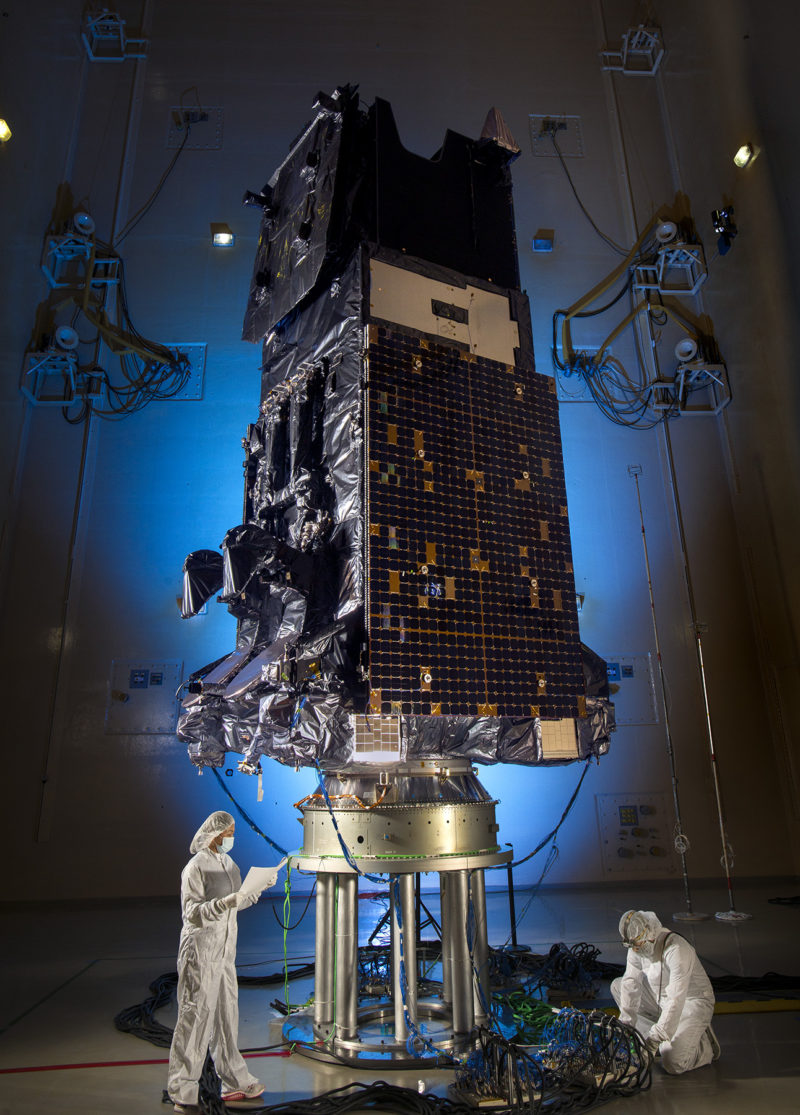
The new SBIRS benefits from 26 enhancements, ranging from improved cyber-hardening, greater spacecraft power, propulsion and electronics, common components to streamline manufacturing and a flexible design architecture. According to Lockheed Martin, the LM2100 Combat Bus architecture will also form the baseline for the upcoming Next-Generation Overhead Passive Infrared (Next-Gen OPIR) Block 0 satellites and the Global Positioning System (GPS) Block III Follow-On series, both of which are expected to enter service around the middle of this decade.
Led by the Infrared Space Systems Directorate at the Air Force’s Space and Missile Systems Center (SMC) at Los Angeles Air Force Base in Los Angeles, Calif., the SBIRS GEO satellites and their ground systems are operated by the 460th Space Wing at Buckley Air Force Base in Aurora, Colo. “SBIRS’ role as an ever-present, on-orbit guardian against global ballistic missile threats has never been more critical,” said Tom McCormick, Lockheed Martin’s vice president for OPIR Systems. “In 2019 alone, SBIRS detected nearly one thousand missile launches, which is about a two-fold increase in two years.”
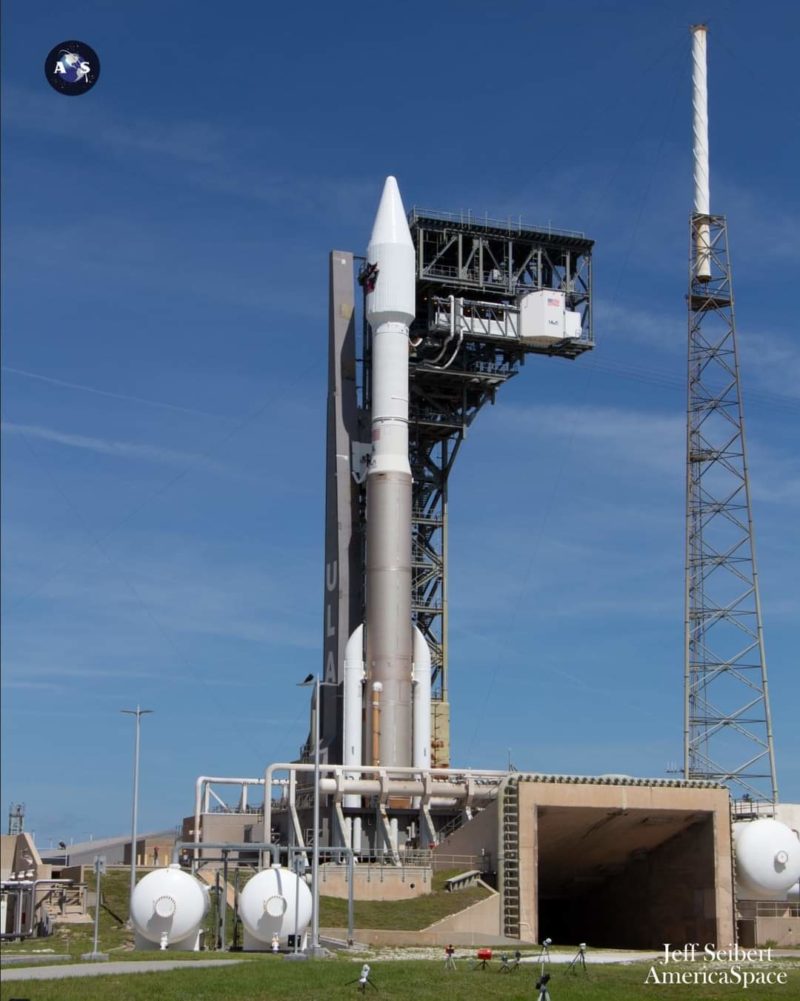
In addition to SBIRS GEO-5, the Atlas V will also be transporting a pair of “Multi-Manifest Satellite Vehicles” on behalf of the Multi-Manifest Office of the Space and Missile Systems Center (SMC), headquartered at Los Angeles Air Force Base in Los Angeles, Calif., in partnership with the U.S. Air Force Academy. Designated “TDO-3” and “TDO-4”, the two 12U CubeSats—each measuring approximately 7.8 x 7.8 x 13.4 inches (20 x 20 x 34 cm)—are set to be deployed shortly before SBIRS GEO-5 itself.
Little has been revealed about their precise objectives, with ULA noting only that “a multi-manifest mission set allows more capability to be placed on-orbit”, with the eventual goal of “providing more critical capabilities to the warfighter”. Two earlier missions with similar designators, TDO-1 and TDO-2, rode aboard Atlas Vs in August 2019 and March 2020, alongside the second-to-last and last Advanced Extremely High Frequency (AEHF) military communications satellites. In the case of TDO-2, the small satellite was released from its perch at the aft-facing end of the Centaur upper stage about a half-hour after liftoff. The two missions focused upon a range of orbital debris tracking and space domain awareness functionality tasks.
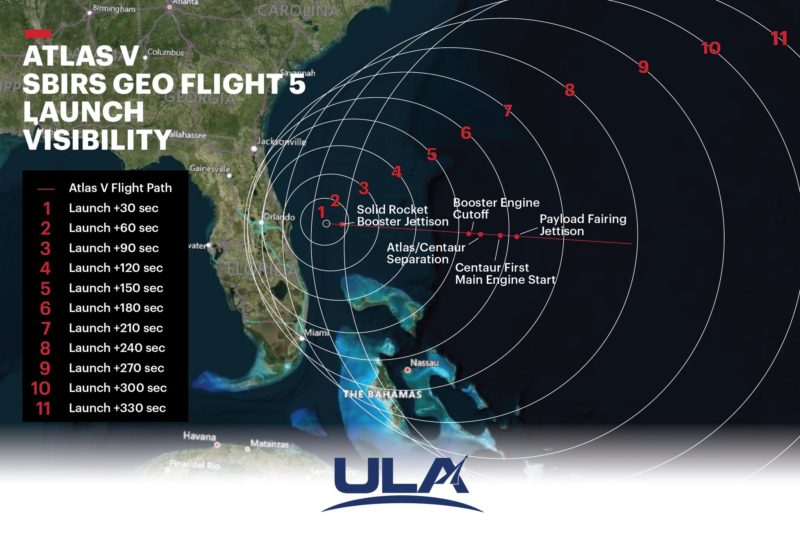
Coming only three weeks since the spectacular 26 April launch of a giant Delta IV Heavy booster from Vandenberg Air Force Base, Calif.—laden with the classified NROL-82 payload for the National Reconnaissance Office—an otherwise flightless spring for ULA seems to be giving way to a busy second half of the year. Following SBIRS GEO-5, a long-delayed mission in support of Space Test Program (STP) objectives is presently targeted for June, with the second uncrewed Orbital Flight Test (OFT-2) of Boeing’s CST-100 Starliner to the International Space Station (ISS) now formally scheduled for 30 July.
– Written by Ben Evans and Mike Killian
.
.
FOLLOW AmericaSpace on Facebook and Twitter!
.
.
Missions » SBIRS »



